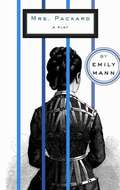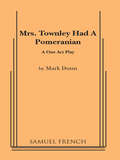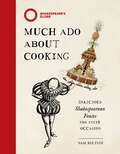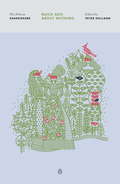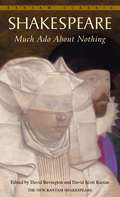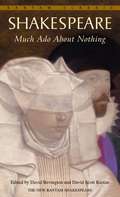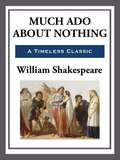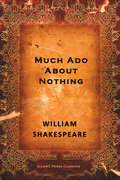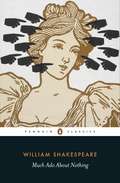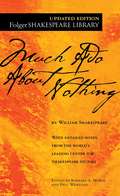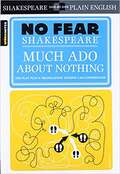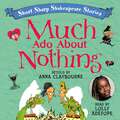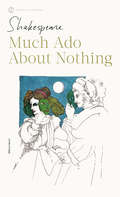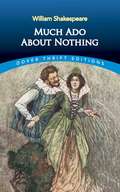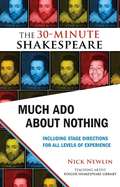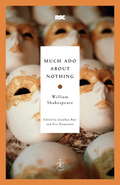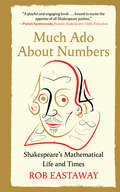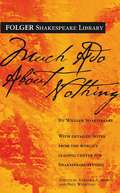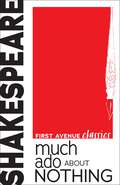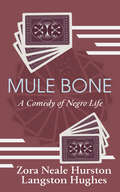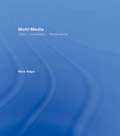- Table View
- List View
Mrs. Packard
by Emily Mann"Emily Mann is one of our most urgently engaging, provocative and significant American playwrights."--Joyce Carol Oates"Elizabeth Packard emerges as a vibrant, passionate force of nature."--The New York TimesIllinois, 1861: Without proof of insanity, Elizabeth Packard is committed by her husband to an asylum. Based on historical events, Emily Mann's play tells of one woman's struggle to right a system gone wrong in this winner of the Kennedy Center Fund for New American Plays Award.Emily Mann is a playwright and director, now in her nineteenth season as artistic director of McCarter Theatre. Her award-winning plays have been produced throughout the world.
Mrs. Townley Had A Pomeranian
by Mark Dunn1 m, 1 f. / Interior / After a horrific bus crash kills most of a small Methodist congregation, Maddie Weathers is contacting grieving families and friends to be sure orphaned pets are being cared for. She and a fellow surviving church member who, like her, is wrestling with his faith, begin to hear a disembodied soprano voice singing hauntingly in the sanctuary. This play about profound loss, tested faith and the definition of God is by the popular author of Belles, Five Tellers Dancing in the Rain and other plays.
Much Ado About Cooking: Delicious Shakespearean Feasts for Every Occasion
by Sam BiltonDelicious recipes inspired by the most famous literary figure in the worldFrom patties and platters to trifles and tarts, food is a key player in Shakespeare's world. With unique recipes from The Globe archives and new ideas inspired by the bard, Much Ado About Cooking is a sumptuous celebration of dishes that capture both the spirit of Shakespeare's literary work and life in the Elizabethan era.Including recipes such as gingerbread, Georgian sweetmeats, spiced beef and saffron buns, this beautiful cookbook features moreish food photography alongside stunning woodcut illustrations, quotes from the plays and fascinating literary facts, so you feast like an Elizabethan and dine like it's 1599.
Much Ado About Nothing
by William Shakespeare Stephen Orgel Peter Holland A. R. BraunmullerThe acclaimed Pelican Shakespeare series, now in a dazzling new series design The Pelican Shakespeare series features authoritative and meticulously researched texts paired with scholarship by renowned Shakespeareans. Each book includes an essay on the theatrical world of Shakespeare’s time, an introduction to the individual play, and a detailed note on the text used. Updated by general editors Stephen Orgel and A. R. Braunmuller, these easy-to-read editions incorporate over thirty years of Shakespeare scholarship undertaken since the original series, edited by Alfred Harbage, appeared between 1956 and 1967. With stunning new covers designed by Manuja Waldia, definitive texts, and illuminating essays, the Pelican Shakespeare will remain a valued resource for students, teachers, and theater professionals for many years to come.This edition of Much Ado About Nothing is edited with an introduction by Peter Holland.For more than seventy years, Penguin has been the leading publisher of classic literature in the English-speaking world. With more than 1,700 titles, Penguin Classics represents a global bookshelf of the best works throughout history and across genres and disciplines. Readers trust the series to provide authoritative texts enhanced by introductions and notes by distinguished scholars and contemporary authors, as well as up-to-date translations by award-winning translators.From the Trade Paperback edition.
Much Ado About Nothing
by William Shakespeare David Bevington David Scott KastanSet in a courtly world of masked revels and dances, this play turns on the archetypal story of a lady falsely accused of unfaithfulness, spurned by her bridegroom, and finally vindicated and reunited with him. Villainy, schemes, and deceits threaten to darken the brilliant humor and sparkling wordplay-but the hilarious counterplot of a warring couple, Beatrice and Benedick, steals the scene as the two are finally tricked into admitting their love for each other in Shakespeare's superb comedy of manners.Each Edition Includes:* Comprehensive explanatory notes * Vivid introductions and the most up-to-date scholarship * Clear, modernized spelling and punctuation, enabling contemporary readers to understand the Elizabethan English* Completely updated, detailed bibliographies and performance histories * An interpretive essay on film adaptations of the play, along with an extensive filmographyFrom the Paperback edition.
Much Ado About Nothing
by William ShakespeareThis is a story of a lady wrongly accused of treachery, spurned by her bridegroom, and finally justified and reunited with him. Villainy, schemes, and deceits threaten to darken the humor and sparkling word play.
Much Ado About Nothing
by William Shakespeare"Much Ado About Nothing" is the story of Leonato, an Italian nobleman, his daughter, Hero, and his niece, Beatrice. Following a war Leonato welcomes into his house Don Pedro, his good friend; fellow soldiers of Don Pedro, Claudio and Benedick; as well as Don Pedro's illegitimate brother, Don John. Quickly amorous relations develop between Claudio and Hero and later between Benedick and Beatrice. As wedding plans are being made for Claudio and Hero, Don John tricks Claudio into believing that Hero has been unfaithful. The wedding bliss is briefly interrupted until the truth is finally discovered and the play ends in a joyful double wedding.
Much Ado About Nothing
by William ShakespeareTwo couples—Benedick and Beatrice, and Hero and Claudio—must overcome deception, gossip, and, occasionally, their own misplaced pride if their love is to persevere.
Much Ado About Nothing
by William Shakespeare'We go to Shakespeare to find out about ourselves' Jeanette WintersonBeatrice and Benedick both claim they are determined never to marry. But when their friends trick them into believing that each harbours secret feelings for the other, the pair begin to question whether their witty banter and verbal sparring conceal something deeper. Schemes abound, dangerous misunderstandings proliferate and matches are eventually made in this dazzling, dark-edged comedy of mature love and second chances. Used and Recommended by the National TheatreGeneral Editor Stanley WellsEdited by R. A. FoakesIntroduction by Janette Dillon
Much Ado About Nothing (Folger Shakespeare Library)
by William ShakespeareThe authoritative edition of Much Ado About Nothing from The Folger Shakespeare Library, the trusted and widely used Shakespeare series for students and general readers. One of Shakespeare&’s most frequently performed comedies, Much Ado About Nothing includes two quite different stories of romantic love. Hero and Claudio fall in love almost at first sight, but an outsider, Don John, strikes out at their happiness. Beatrice and Benedick are kept apart by pride and mutual antagonism until others decide to play Cupid. The Folger Library is the nation&’s best, most navigable and most respected resource for Shakespeare scholarship and teaching. The authoritative edition of Much Ado About Nothing features the side-by-side format favored by both students and teachers, as well as guides to the play&’s most famous lines and Shakespearean phrases and language. This edition includes: -The exact text of the printed book for easy cross-reference -Hundreds of hypertext links for instant navigation -Freshly edited text based on the best early printed version of the play -Full explanatory notes conveniently linked to the text of the play -Scene-by-scene plot summaries -A key to the play&’s famous lines and phrases -An introduction to reading Shakespeare&’s language -An essay by a leading Shakespeare scholar providing a modern perspective on the play -Fresh images from the Folger Shakespeare Library&’s vast holdings of rare books -An annotated guide to further reading Essay by Gail Kern Paster The Folger Shakespeare Library in Washington, DC, is home to the world&’s largest collection of Shakespeare&’s printed works, and a magnet for Shakespeare scholars from around the globe. In addition to exhibitions open to the public throughout the year, the Folger offers a full calendar of performances and programs. For more information, visit Folger.edu.
Much Ado About Nothing (No Fear Shakespeare)
by SparkNotesDon’t be intimidated by Shakespeare! These popular guides make the Bard’s plays accessible and enjoyable.
Much Ado About Nothing (Short, Sharp Shakespeare Stories #29)
by Anna ClaybourneAs merry as the day is long.Mistaken identities, jealous relatives, lovers' quarrels and a happy ending... Discover the entertaining story at the heart of Much Ado About Nothing, one of Shakespeare's best-loved comedies.As well as the story, this audiobook contains information about the background to Much Ado About Nothing, its major themes, language, and Shakespeare's life during the time he was writing the play. Gossip, and its role in society in 16th century England, is also examined, to give some context in which the play was written.The Short, Sharp Shakespeare series consists of six books that retell Shakespeare's most famous plays in modern English. Fun sound effects and atmospheric music accompany each narration, making them a great introduction to "the Bard" for children.(P) 2023 Hodder & Stoughton Limited
Much Ado About Nothing (SparkNotes Literature Guide Series)
by SparkNotesMuch Ado About Nothing (SparkNotes Literature Guide) by William Shakespeare Making the reading experience fun! Created by Harvard students for students everywhere, SparkNotes is a new breed of study guide: smarter, better, faster. Geared to what today's students need to know, SparkNotes provides: *Chapter-by-chapter analysis *Explanations of key themes, motifs, and symbols *A review quiz and essay topicsLively and accessible, these guides are perfect for late-night studying and writing papers
Much Ado About Nothing (The New Cambridge Shakespeare)
by William Shakespeare F. H. MaresFamous actors have appeared as this play's sparring lovers, Benedick and Beatrice, from David Garrick's time in the eighteenth century to the present. Angela Stock has added a new section to the Introduction where she reviews the romantic and darker, more cynical aspects of the play in the context of late twentieth-century stage, film and critical interpretations. She also tackles the critical fortunes of Hero and Claudio as they reflect the play's concerns with sexuality and misogyny, eavesdropping and deception.
Much Ado About Nothing: A Comedy
by William ShakespeareThe Signet Classics edition of William Shakespeare's grand romantic comedy.Much Ado About Nothing casts the lovers Benedick and Beatrice in a witty war of words while the young Claudio is tricked into believing his love Hero has been unfaithful in this play that combines robust humor with explorations on honor and shame. This revised Signet Classics edition includes unique features such as: • An overview of Shakespeare's life, world, and theater • A special introduction to the play by the editor, David L. Stevenson• A note on the sources from which Shakespeare derived Much Ado About Nothing • Dramatic criticism from Charles Gildon, Lewis Carroll, George Bernard Shaw, and others • A comprehensive stage and screen history of notable actors, directors, and productions • Text, notes, and commentaries printed in the clearest, most readable text • And more...
Much Ado About Nothing: A Comedy (Dover Thrift Editions: Plays)
by William ShakespeareMuch Ado About Nothing is one of Shakespeare's most imaginative and exuberant comedies, contrasting two pairs of lovers in a witty and suspenseful battle of the sexes. Attracted to each other, the maddeningly skeptical Beatrice and Benedick are dead-locked in a lively war of words until their friends hatch a plot to unite them. The mutually devoted Hero and Claudio, on the other hand, all too quickly fall victim to a malicious plot to part them. Near-fatal complications ensue, but with the help of the hilarious Constable Dogberry and his confederates, the lovers are ultimately united.First presented in 1598, Much Ado About Nothing is one of Shakespeare's last comedies. Its darker undercurrents foreshadow the playwright's growing concern with the frailties of human character that would dominate his late tragedies. But in its clever turns of plot, vivacious displays of wit, jovial conversations, and charming songs, this merry comedy is among Shakespeare's most artistic creations.
Much Ado About Nothing: The 30-Minute Shakespeare
by Nick NewlinPlanning a school or amateur Shakespeare production? The best way to experience the plays is to perform them, but getting started can be a challenge: The complete plays are too long and complex, while scene selections or simplified language are too limited."The 30-Minute Shakespeare" is a new series of abridgements that tell the "story" of each play from start to finish while keeping the beauty of Shakespeare's language intact. Specific stage directions and character suggestions give even inexperienced actors the tools to perform Shakespeare with confidence, understanding, and fun!This cutting of Shakespeare's utterly charming and popular comedy MUCH ADO ABOUT NOTHING features five key scenes, including Beatrice and Benedick's classic initial word-battle, and the uproarious hide-and-seek deception of the two "lovers." The next scenes are the brutal rejection of Hero at the altar by a deceived Claudio and the timeless manhandling of the English language by the bumbling constable Dogberry. In the fifth and final scene, Shakespeare resolves the play's conflicts and confusions, and love reigns again. This cutting really tells the story, and includes some sidesplitting stage business, particularly the back-and-forth physical and verbal parrying between Benedick and Beatrice.The edition also includes an essay by editor Nick Newlin on how to produce a Shakespeare play with novice actors, and notes about the original production of this abridgement at the Folger Shakespeare Library's annual Student Shakespeare Festival.
Much Ado About Nothing: The RSC Shakespeare (Modern Library Classics)
by William ShakespeareFrom the Royal Shakespeare Company â " a fresh new edition of Shakespeare's much-loved comedy of the battle between the sexes THIS EDITION INCLUDES: â ¢ An illuminating introduction to Much Ado About Nothing by award-winning scholar Jonathan Bate â ¢ The play - with clear and authoritative explanatory notes on each page â ¢ A helpful scene-by-scene analysis and key facts about the play â ¢ An introduction to Shakespeare's career and the Elizabethan theatre â ¢ A rich exploration of approaches to staging the play featuring photographs of key productions The most enjoyable way to understand a Shakespeare play is to see it or participate in it. This unique edition presents a historical overview of Much Ado About Nothing in performance, recommends film versions, takes a detailed look at specific productions and includes interviews with two leading directors and an actor â " Nicholas Hytner , Marianne Elliott and Harriet Walter â " so that we may get a sense of the extraordinary variety of interpretations that are possible, a variety that gives Shakespeare his unique capacity to be reinvented and made â our contemporary' four centuries after his death. Ideal for students, theatre-goers, actors and general readers, the RSC Shakespeare editions offer an accessible and contemporary approach to reading and rediscovering Shakespeare's works for the twenty-first century.
Much Ado About Numbers: Shakespeare's Mathematical Life and Times
by Rob EastawayOpen a new portal into Shakespeare’s words—and his Renaissance life—with math and numbers as your key. Shakespeare’s era was abuzz with mathematical progress, from the new concept of “zero” to Galileo’s redraft of the heavens. Now, Rob Eastaway uncovers the many surprising ways math shaped Shakespeare’s plays—and his world—touring astronomy, code-breaking, color theory, navigation, music, sports, and more. How reliable was a pocket sundial? Was math illusionist John Dee the real-life Prospero? How long was a Scottish mile, and what could you buy for a groat? Do Jupiter’s moons have a cameo in Cymbeline? How did ordinary people use numbers day to day? And might Shakespeare have tried that game-changing invention—the pencil? Full of delights for devotees of both Tudor history and the Bard, Much Ado About Numbers is proof that the arts and sciences have always danced together.
Much Ado about Nothing (The Folger Shakespeare Library)
by William ShakespeareMuch Ado About Nothing is one of Shakespeare's more popular comedies, with a long history of success on the stage. Much of its appeal lies in its two stories of romantic love with their quite different journeys to comedy's happy ending. Hero and Claudio fall in love almost at first sight; their union has the blessing of the older generation (in the persons of Hero's father, Leonato, and Claudio's prince, Don Pedro).
Much Ado about Nothing: A Comedy (First Avenue Classics ™)
by William ShakespeareWhile staying at his friend Leonato's home, Claudio falls in love with Hero, Leonato's beautiful daughter, and they agree to marry. In the meantime, they decide to trick their friends Benedick and Beatrice—who have nothing but insults for each other—into falling in love as well. However, Don John, the illegitimate brother of Leonato's close friend Don Pedro, won't stand for such happiness. He tricks Claudio into thinking Hero has been unfaithful. Claudio's hasty overreaction and Leonato's redemption of Hero wield all the tools of a romantic comedy, making a story that is, indeed, much ado about nothing. This unabridged version of William Shakespeare's delightful play was first published in England in 1600.
Mule Bone: A Comedy of Negro Life
by Langston Hughes Zora HurstonHoliding an exceptional place in the history of African-American theater, Mule Bone is the energetic and often farcical play co-written by Harlem Renaissance luminaries Zora Neale Hurston and Langston Hughes. The play centers on a two-man song-and-dance team and the woman who comes between them. Jealousy between the men erupts with the use of a mule bone as a weapon, and the ensuing hilarity and chaos splits the town into two factions.
Multi-media: Video – Installation – Performance
by Nick KayeMulti-media charts the development of multi-media video, installation and performance in a unique dialogue between theoretical analysis and specially commissioned documentations by some of the world’s foremost artists. Nick Kaye explores the interdisciplinary history and character of experimental practices shaped in exchanges between music, installation, theatre, performance art, conceptual art, sculpture and video. The book sets out key themes and concerns in multi-media practice, addressing time, space, the resurgence of ephemerality, liveness and ‘aura’. These chapters are interspersed with documentary artwork and essays by artists whose work continues to shape the field, including new articles from: Vito Acconci The Builders Association John Jesurun Pipilotti Rist Fiona Templeton. Multi-media also reintroduces a major documentary essay by Paolo Rosa of Studio Azzurro in a new, fully illustrated form. This book combines sophisticated scholarly analysis and fascinating original work to present a refreshing and creative investigation of current multi-media arts practice.
